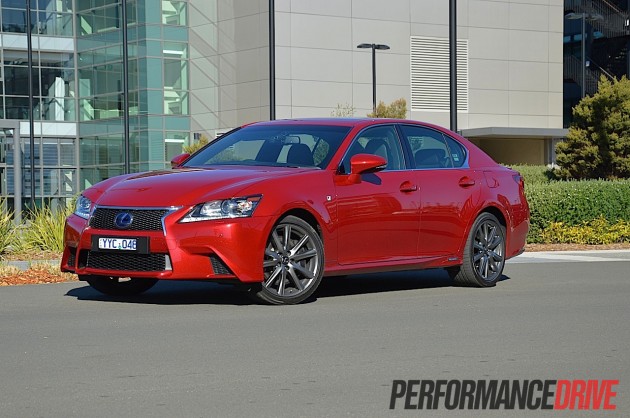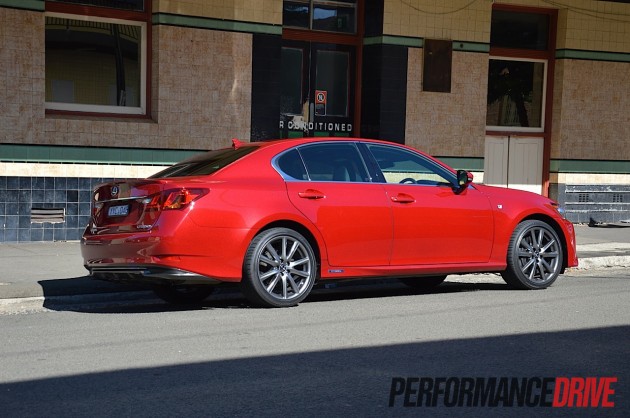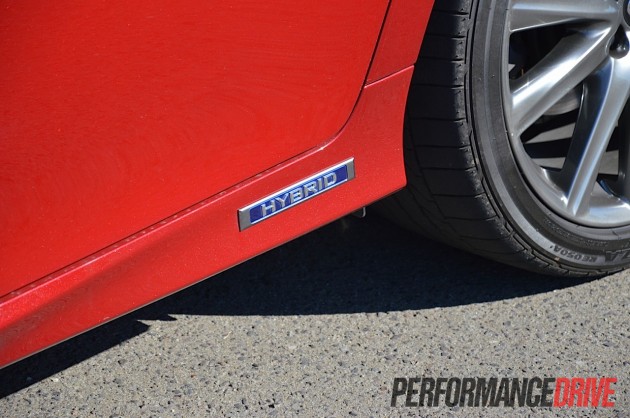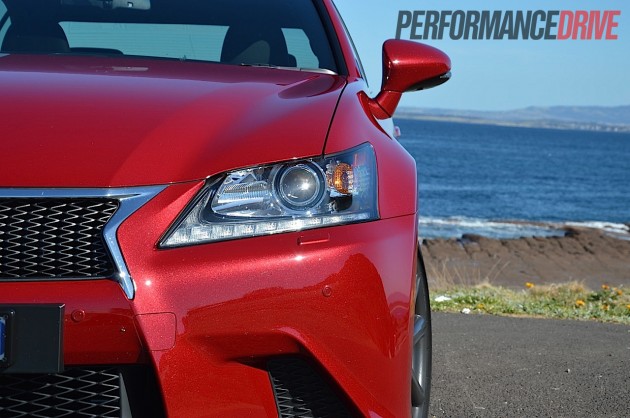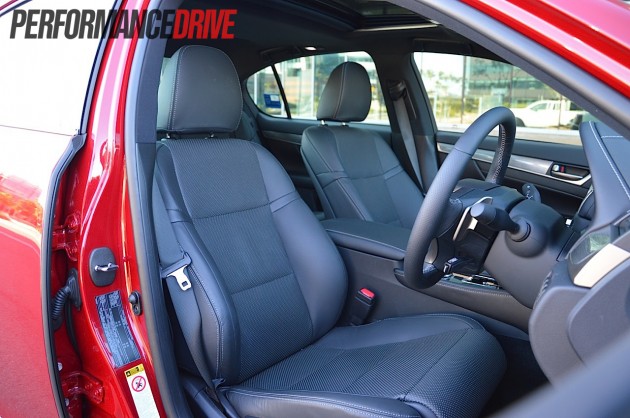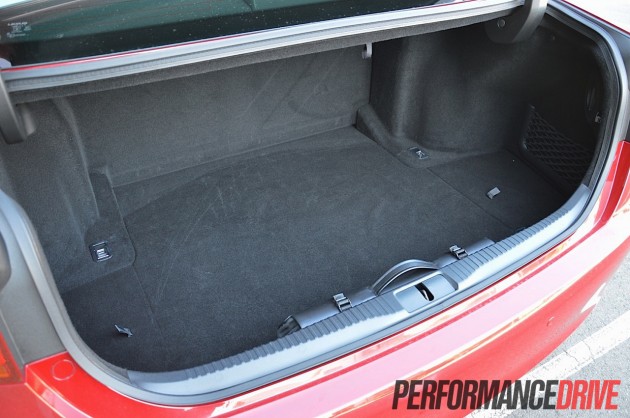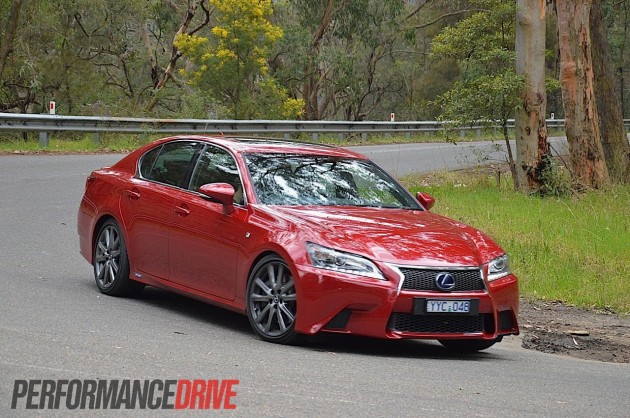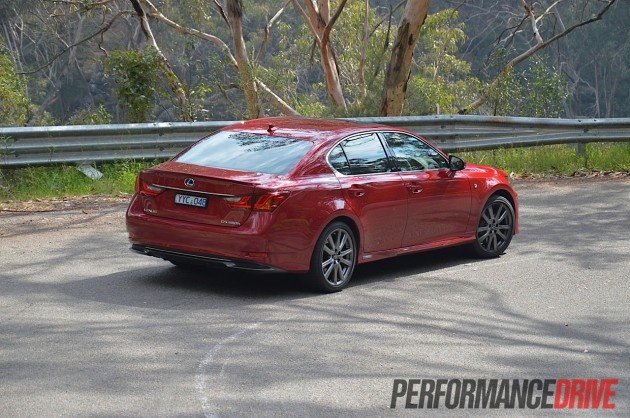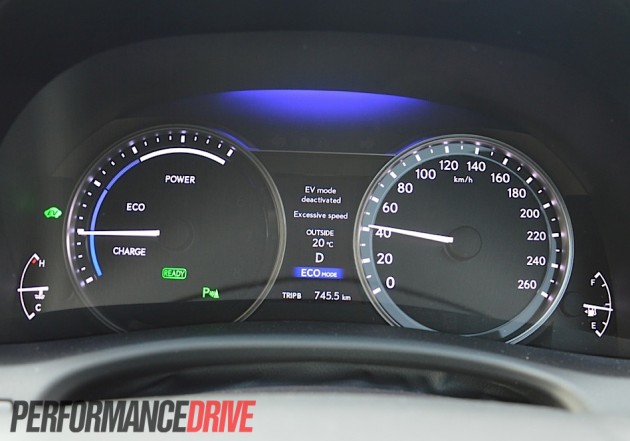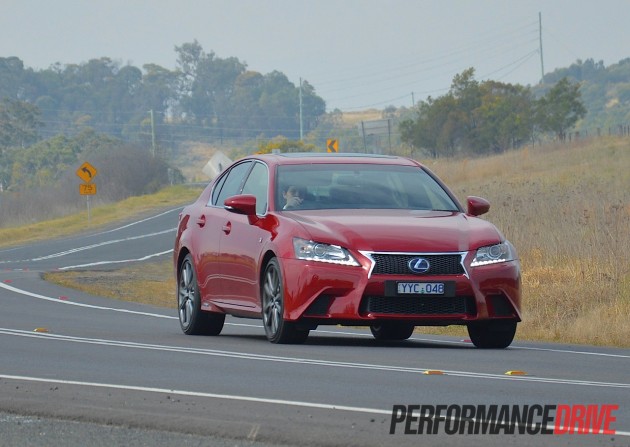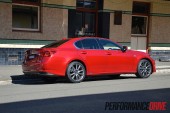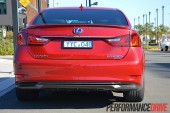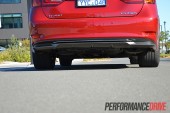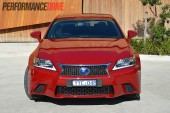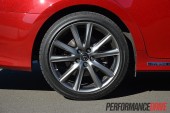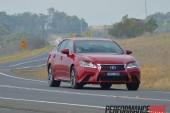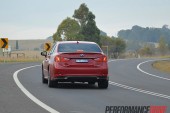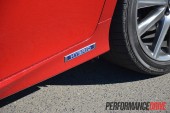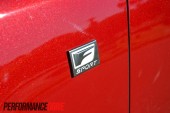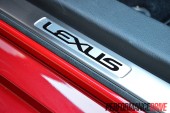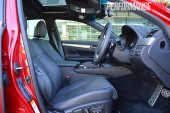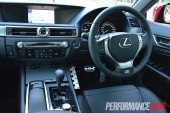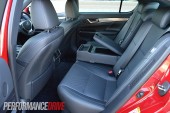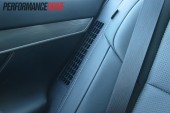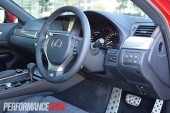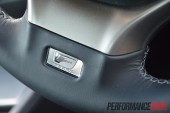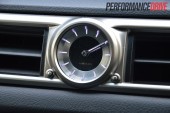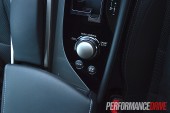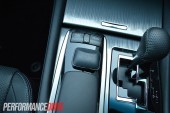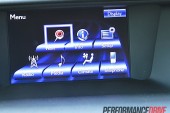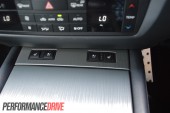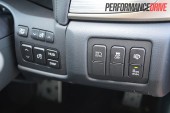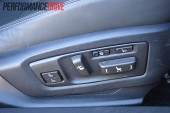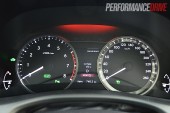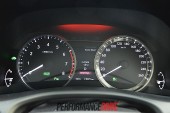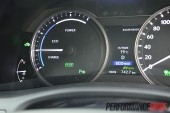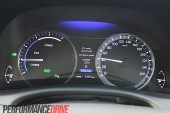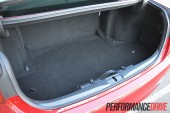Have you ever wondered what the quickest hybrid vehicle currently on the market is? Wonder no more, you’re looking at it. It’s the 2012 Lexus GS 450h F Sport. It comes with a factory 0-100km/h time of just 5.9 seconds.
The GS is not only about being quick though, it’s also about fine luxury, intelligence and technology, and, with the help of the F Sport pack, driver enjoyment and performance.
2012 LEXUS GS 450H F SPORT – PROS AND CONS
PROS:
- Pleasurable steering and overall drive
- Very comfortable and smooth soothing ride
- Excellent fuel economy, especially for the performance
- Class-leading price compared with the top-line rivals
- Outstanding F Sport brakes
CONS:
- F Sport suspension could be a bit firmer in ‘Sport +’ mode
- CVT auto isn’t all that inspiring, GS 350 six-speed auto much better
- V6 soundtrack subdued compared with great-sounding GS 350 (almost identical engine)
2012 LEXUS GS 450H F SPORT – OVERVIEW
The problem with many top-line luxury sedans is that they more often than not come with a big petrol-guzzling engine. It’s all well and good if all you want is power and performance, but that’s not really what the large luxury car segment is all about.
It’s about being pampered while you drive. It’s about leading-edge technology, and about the car making the drive as pleasurable and easy as possible. And this should mean no getting out and filling up the petrol tank every few days.
This is where the 2012 Lexus GS 450h F Sport comes in. It’s a very luxurious large sedan that’s packed full of techno gizmos and intelligent automatic features, but it’s also propelled by a smart petrol engine and electric motor hybrid system. On top of this, the F Sport variant (as tested) adds in the extra element of enhanced performance and sportiness.
Power comes from the Lexus 2GR-FXE 3.5-litre V6 petrol engine – as seen in the GS 350 in a higher state of tune – producing 215kW of power at 6000rpm and 352Nm of torque at 4500rpm. This is supported by a new Atkinson cycle 650-volt synchronous electric drive motor which produces 147kW of power and 275Nm of torque. Combined power is rated at 254kW.
Not only does this sound impressive, the new GS 450h breaks out of the mould by being the world-first in a number of areas. It’s the world’s first hybrid available with all-wheel steering; the first to feature an Atkinson cycle engine driving the rear wheels; and the first Atkinson cycle engine to feature direct and port injection.
Prices for the 450h F Sport start at $111,900 (excluding on-road costs). The GS 450h is also available in the entry-level Luxury and top-line Sport Luxury trim.
2012 LEXUS GS 450H F SPORT – START UP AND 0-100KM/H ACCELERATION VIDEO
2012 LEXUS GS 450H F SPORT – ACCOMMODATION AND EQUIPMENT
If you’re wanting to opt for the F Sport package you obviously have a bit of spice in your appetite. Lexus delivers here. The F Sport comes with its own unique sports bucket seats with electronically adjustable side bolsters, aluminium rubber-studded pedals, paddles shifters, and a sports steering wheel.
It all feels quite sporty inside, with the front seats providing plenty of support for the corners, especially with those adjustable side bolsters. The seats are also cushy and comfortable for long journeys, and feature a heating and cooling function with leather ventilation. You can feel the chair breathing behind you as you drive along; perfect for summer as sometimes leather can get a bit sweaty.
There’s no confusion about the fact this is a luxury-focused car, however, highlights such as brushed stainless-steel-look trimmings on the dash and door cards and the piano black sections on the centre console give it an intelligent yet ready-to-play kind of feel. Like a businessman out on the town.
The GS 450h also gets head up display, a reverse camera and parking sensors, 12-way electric adjustable front seats with memory functions, a comprehensive multimedia interface with satellite navigation, and an adaptive drive system with Eco, Sport, and Sport + modes which alter the suspension and throttle response.
In the F Sport’s case, there’s also sports suspension, bigger brakes with four-piston calipers on the front, Dynamic Rear Steering (DRS), and a set of 19-inch dark alloy wheels which blend in with an aggressive bodykit. The kit includes bespoke front and rear bumper bars that feature sharp and swooping lines, like they were formed with a sword, and a large mesh front grille.
The good thing about Lexus is everything you see comes as standard. You simply decide which variant you want – Luxury, F Sport, or Sport Luxury – and each comes with an extensive list of features in accordance with the theme of the variant. All three present great value in comparison to what the competition offers, or rather, what the competition offers as an option.
2012 LEXUS GS 450H F SPORT – DESIGN AND SAFETY
In terms of design, the new GS 450h has been improved significantly over the previous model. It’s all much sharper and more focused, especially at the front. It’s also very imposing in the flesh with that huge ‘spindle’ grille layout and slightly frowning LED daytime running lights giving a steely stare.
Lexus has designed the new GS flagship hybrid with improved practicality too. The battery, for instance, is mounted between the two rear suspension towers behind the rear seats. It has been developed to allow for a 45 per cent increase in boot space over the old model, with up to 465 litres on offer compared with 320 litres.
As you can see, the back wall of the boot is fairly shallow but there’s still plenty of depth. Additionally, the battery in this position helps to provide an almost 50:50 overall weight distribution for increased handling performance.
As for safety, Australia’s ANCAP is yet to test the new model, as are the people at Euro NCAP testing facilities. With the amount of safety tech packed into the GS, you could cart around your mother’s favourite heirloom and feel at ease. It comes with radar-guided cruise control, 10 airbags, and traction and stability control.
We found the traction and stability control system to be very good. It can anticipate the road and corners ahead and will brake individual wheels to help guide you around the corner, and not just when slip is detected.
For example, if you swing the GS into a corner with a bit of vigour, without tyre squeal, the individual front right or left wheel will brake to help pivot the car around the corner. Basically, what this means is before any slip is even reached or detected, the GS is already setting itself up for a smooth and safe path.
The radar-guided cruise control system is fairly good too, although, it’s not quite as smooth in operation or as fine-tuned as the systems found in Volvo’s latest vehicles.
When you creep up behind a vehicle with the system engaged it sometimes brakes a little too much, wiping off more speed than what is really required. You then find yourself causing a bit of a chain reaction behind you as cars slow down and then speed back up again.
The system won’t bring the car all the way to a dead stop either. Instead, it sends off a warning buzzer at around 40km/h to hand the car back over to you.
2012 LEXUS GS 450H F SPORT – ON THE ROAD
We loved the way the new GS 350 Sport Luxury drove when we tested it a few months ago. The suspension worked wonderfully over every type of road that we through at it, including bumpy and twisty mountain roads, as well as higher speed sweeping country highways.
We were expecting the F Sport to come with a much firmer suspension setup, almost to the point of being too firm. Many experts around the world have criticised F Sport models in the past for having suspension that is too firm. For the 450h F Sport, this is not the case.
In the most relaxed driving mode in either Eco or Normal, the GS 450h F Sport is lovely on the highway, and on pretty much any road really. The suspension is absorbent making you feel like you’re riding along on a cloud, but at the same time there isn’t excessive body roll.
Flick it over into the most vigorous Sport+ mode and, although it does change a little, it’s not the big transformation that you might expect, initially. The throttle response is definitely made much more sensitive, but the ride and suspension simply seems like the tyres are pumped up another 10psi.
It’s not until you really grab it by the scruff of the neck that the difference is clearer. The F Sport loves to hook into corners, partly thanks to that rear-steer arrangement. You can get back on the power very early without upsetting its balance too. The best thing though is that you can do this while hitting fairly deep undulations in the road and the GS’s direction isn’t jeopardised in any way. It always feels solid and planted.
This brings us to the steering. It’s of medium weight while being precise and engaging. It’s a nice feel too, with hardly any load-up through tight corners, and no kickback when you get back on the power. It’s a well sorted package, and one that would be really fun to take around somewhere like the Nurburgring.
One of the biggest standouts on the GS F Sport in our opinion are the brakes. They are outstanding, even after wiping off higher speeds over and over again. With the car weighing in at 1910kg, there’s some incredible g-forces to be felt when you’re hard on them too.
This is thanks to huge 356mm two-piece ventilated discs on the front – using aluminium hats to reduce heat deformation – clamped by four-piston calipers. We experienced zero fade, zero pedal drop, and a consistent and confidence-inspiring brake feel during our stints. The brake pedal is more on the hard side, but it’s simply a matter of getting used to in a short drive.
You’ll find it quite difficult to conduct any sort of powersliding antics in the GS 450h F Sport if that’s your thing. Firstly, it is fitted with the widest rear tyres Lexus has ever fitted to a sedan – 9-inch-wide alloys with 265mm tyres – but also because the CVT won’t really allow you to hold any sort of constant ratio.
In terms of drawbacks, it has to be the continuously variable transmission. It’s boring. There’s no nicer way to say it. Floor the throttle and the revs will climb and hold until you’ve reached the speed you want to reach. There is a ‘manual’ mode by slotting the gear lever over, but even then, the transmission doesn’t like to change up when you ask it to. This takes away that great feeling of accelerating through the gears. It’s a shame because the GS 350 is such a joy to do this in.
2012 LEXUS GS 450H F SPORT – VERDICT
If you’re after a vehicle that can cover distances in class and comfort, and one that can do it efficiently – we averaged 8.1L/100km (official average 6.3L/100km) – the 450h is a well engineered option. It’s very intelligent, and you can notice it when you’re behind the wheel.
Even when you take off from the lights, there’s no stop-start in the conventional sense, the car simply departs silently using the electric motors until eventually the petrol engine seamlessly fires into life (above 40km/h, or if you push the throttle with moderate aggression). It’s quite intriguing.
To top it all off the F Sport package gives the GS a performance edge both visually and mechanically. To us, it is just as nice to drive as the BMW 5 Series – perhaps the pinnacle, specifically in terms of driver’s cars, in this segment.
As far as we can see the only letdown to this car is the CVT gearbox. The V6 engine is also toned down a bit and misses out on the throaty variable inlet manifold that the GS 350 gets. Again, a big shame as it gives the GS a proper snorting and roaring sports sedan soundtrack.
Being a Lexus – a product of Toyota – you know it’s all going to last, and that has to be one of its major draw cards. The 450h comes with an eight-year/160,000km warranty on the battery system alone. This gives you piece of mind in regards to taking that plunge and buying a hybrid.
2012 LEXUS GS 450H F SPORT – THE COMPETITORS
(With the GS 450h being a hybrid and focusing on fuel efficiency, we’ll compare it against the other fuel-efficient rivals in this segment. Please note prices are at either end of the spectrum; the 450h is the Lexus flagship and also the most efficient, while the fuel-efficient rivals are also the entry-level variants.)
BMW 520d – 2.0-litre turbo-diesel four-cylinder, 135kW/380Nm – 1625kg – $83,300
Fuel economy is rated at 5.2L/100km, while 0-100km/h comes up in 8.1 seconds. This is more fuel efficient than the GS 450h, but around two seconds slower from 0-100km/h.
Mercedes-Benz E220 CDI – 2.1-litre turbo-diesel four-cylinder, 125kW/400Nm – 1735kg – $84,800
Fuel economy is rated at 5.2L/100km, while 0-100km/h is rated at 8.6 seconds. Again, more fuel efficient than the Lexus but over two seconds slower to 100km/h.
Audi A6 2.0TDI – 2.0-litre turbo-diesel four-cylinder, 130kW/380Nm – 1575kg – $78,900
Fuel economy is rated at a class-leading 5.0L/100km. It also comes with all-wheel drive – the only vehicle in this segment in Australia with all-paw grip.
2012 LEXUS GS 450H F SPORT – SPECIFICATIONS
MODEL
2012 Lexus GS 450h F Sport
ENGINE
3.5-litre V6 petrol with hybrid Atkinson cycle electric motor assistance
ENGINE SIZE / COMPRESSION RATIO
3456cc / 13:1
BORE X STROKE
94mm x 83mm
POWER
Petrol engine: 215kW@6000rpm, 352Nm@4500rpm
Electric motor: 147kW, 275Nm
Combined output: 254kW (combined torque not available)
POWER TO WEIGHT RATIO
7.5: 1 (kg:kW)
KERB WEIGHT
1910kg
HEIGHT / WIDTH / LENGTH
1850mm / 1460mm / 4850mm
DRIVETRAIN
Six-step electronic continuously variable transmission (CVT) with paddle shifters, rear-wheel drive and Dynamic Rear Steering
BRAKES
F: 356mm x 30mm ventilated two-piece discs, four-piston calipers
R: 310mm x 18 ventilated discs, single-piston calipers
WHEELS / TYRES
Front: 19 x 8-inch alloy, 235/40
Rear: 19 x 9-inch alloy, 265/35
FUEL TANK CAPACITY
66 litres
FUEL TYPE
95 RON
FUEL CONSUMPTION
Tested average: 8.1L/100km
Official average: 6.3L/100km
PERFORMANCE
0-100km/h: 6.7 seconds (tested)
PRICED FROM
$111,900
WARRANTY
Four-year/Unlimited kilometre
